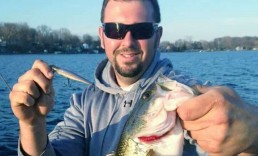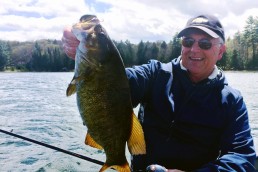Can Coots Lead you to Early Springtime Bass?
SHARE THIS POST
As an avid duck hunter, I’ve heard folks ask over the years whether those abundant coots you see on lakes around the Midwest in fall and spring are good to eat or not. I saw a recipe once that used a ton of garlic and hot sauce and proclaimed that coots could be broiled or grilled to perfection. I think if you like garlic and hot sauce, the same recipe could have worked to make an old life jacket edible.
They might not be good to eat, but in the spring, coots are a valuable commodity for finding the first bass of the year. When you see them on the water swimming around and diving, you can bet they’re eating fresh, green weeds. After a long winter, green weeds attract bass like free beer attracts some of my fishing buddies. Coots can find the fresh stuff on any body of water.
The reason bass are around green weeds is that lots of weeds die off in the winter, whether or not the lake gets covered with ice. Less sunlight takes its toll on a lake’s vegetation, and areas of a lake with patches of coontail and cabbage weeds will usually have more oxygen. Plus, those remaining weeds often hold large numbers of baitfish and baby panfish—they’ll be in those weeds more densely than during the rest of the year simply because the lake has fewer weeds overall.
Most of the time, bass are rather lethargic, but still have a killer instinct in the cold water of spring. Sometimes you can provoke a reaction strike with a crankbait or a spinnerbait crashing through their strike zone. You can get these cold-water fish to bite a finesse presentation, such as a tube bait or a small worm like the Ned Rig. However, the most consistent cold-water producer for me and many angling friends is the classic jerkbait.
Rogues, Husky Jerks, Rebel Minnows, Strike King KVD J200s, and the like, are all examples of jerkbaits anglers can use for early success. But this time of year, a better name for jerkbaits might be “twitch-and-settlebaits.” That’s because instead of ripping a jerkbait through the living room of a bass like you can do successfully later in the spring or in the fall, a slower, pausing retrieve is usually more effective.
In fact, watch a jerkbait angler who knows what he’s doing in the spring, and it looks almost like he’s free-lining a live, unweighted shiner minnow out there. He’s holding his rod tip high and watching his line, occasionally tightening up the slack and giving it a quick twitch. And then, he waits and watches his line some more.
“You can’t let a jerkbait pause long enough,” says my friend, Randy VanDam, brother of a fellow named Kevin and father of one of my best friends, touring bass pro Jonathon VanDam.
I tend to disagree with Randy, but only because I’m too impatient to let a jerkbait set for more than 10 or 20 seconds. On a really good day, without drinking much coffee, I can let it set for 30 seconds. But I know patience is something I need to work on, and letting the lure set there longer will get me some more bites. Sometimes bites don’t happen until the lure has sat there for a whole minute—or so I’ve heard. I’ve never let one just sit there for that long. This year I might bring along a stopwatch and actually time the pauses just to see if I can let it sit there for a minute or more.
Here’s another critical point: Use a jerkbait that suspends, not one that floats. Bass won’t often go to the surface to suck down a motionless minnow-imitator this time of year, largely because there aren’t usually many dying minnows floating on the surface. Bass will, however, often suck down a minnow that is suspended, maybe rotating its tail or nose toward the bottom ever so slowly. Bass will inhale a jerkbait, too, if it’s suspending and moving slowly, like a dying fish.
Are you enjoying this post?
You can be among the first to get the latest info on where to go, what to use and how to use it!
Winter and prolonged cold water without a lot of food is tough on baitfish, and lots of them; they’re stressed to the max and basically give up the ghost in early spring. A bass as a predator has the job of keeping lakes free of dying fish, and they take on this responsibility with varying degrees of enthusiasm. They don’t seem to like to chase fast-moving bait a long way in cold water, but they will come from a good ways away and eat it if the bait is still kicking a little, but not moving far. Hence the slow, pausing twitching retrieve.
Many jerkbaits suspend right out of the box and you don’t have to modify them to get them to lollygag in the water column. My favorite baits are the ones that suspend, but start to float slowly upward. I like to take these and add a SuspenDot or two to the belly of the lure, just in front of the rear hook. Storm SuspenDots are basically a small circle of lead foil with a sticky back. This tiny bit of added weight will make the lure act like a dying goldfish sucking for air. When you twitch, the nose shoots downward, making the lure sit horizontally for a moment, and as you let it set, the nose slowly moves upward. Bass have a hard time resisting this slow, subtle action.
Many experienced bass anglers use spinning gear for jerkbait, feeling they can get longer casts and cover more water. They can also use lighter line in lakes with super clear water in spring. I prefer a baitcaster, just because I feel like I have better control of the lure. I can still use 8-pound-test line on a baitcaster in clear water, too. For rods, I like something with medium action and a medium-fast tip, 7 feet or longer to keep the line above the water’s surface as I watch it for strikes. A faster tip with a heavier action rod can pull the bait too hard when the fish grabs it, and the jerkbait’s smaller hooks might not hit home.
Along these same lines, I have found that a hard hookset can miss fish. I prefer to “reel and lean” when I get a bite. I just tighten up the line and pull those sharp little jerkbait hooks into the lip of the bass.
One final note: Perch colors are great in the spring, as lots of baby perch kick the bucket after a long winter. I also like the tannish-yellowish AYU color offered in the Strike King KVD J200. I’ve no idea what the bass think this is, but it’s a subtle color with a little bit of flash and they do eat it up.
So this spring, look for coots, and learn to enjoy watching them do their running takeoff from the water when you move your bass boat into their midst. As you start fishing the weeds those coots just showed you, watch where the flock goes. They’ll likely land in a different part of the lake and start feeding again in your next spot.
Tournament angler and avid outdoorsman Buck Mallory of Lawton, Michigan is a regular contributor to MidWest Outdoors, specializing in bass fishing.
MWO
SHARE THIS POST
You may also like...
0 CommentsGreat Shallow-water Bass Action Right Now
Did you enjoy this post?
You can be among the first to get the latest info on where to go, what to use and how to use it!
Buck Mallory
Tournament angler and avid outdoorsman Buck Mallory of Lawton writes Michigan-specific bass fishing articles for MidWest Outdoors.


